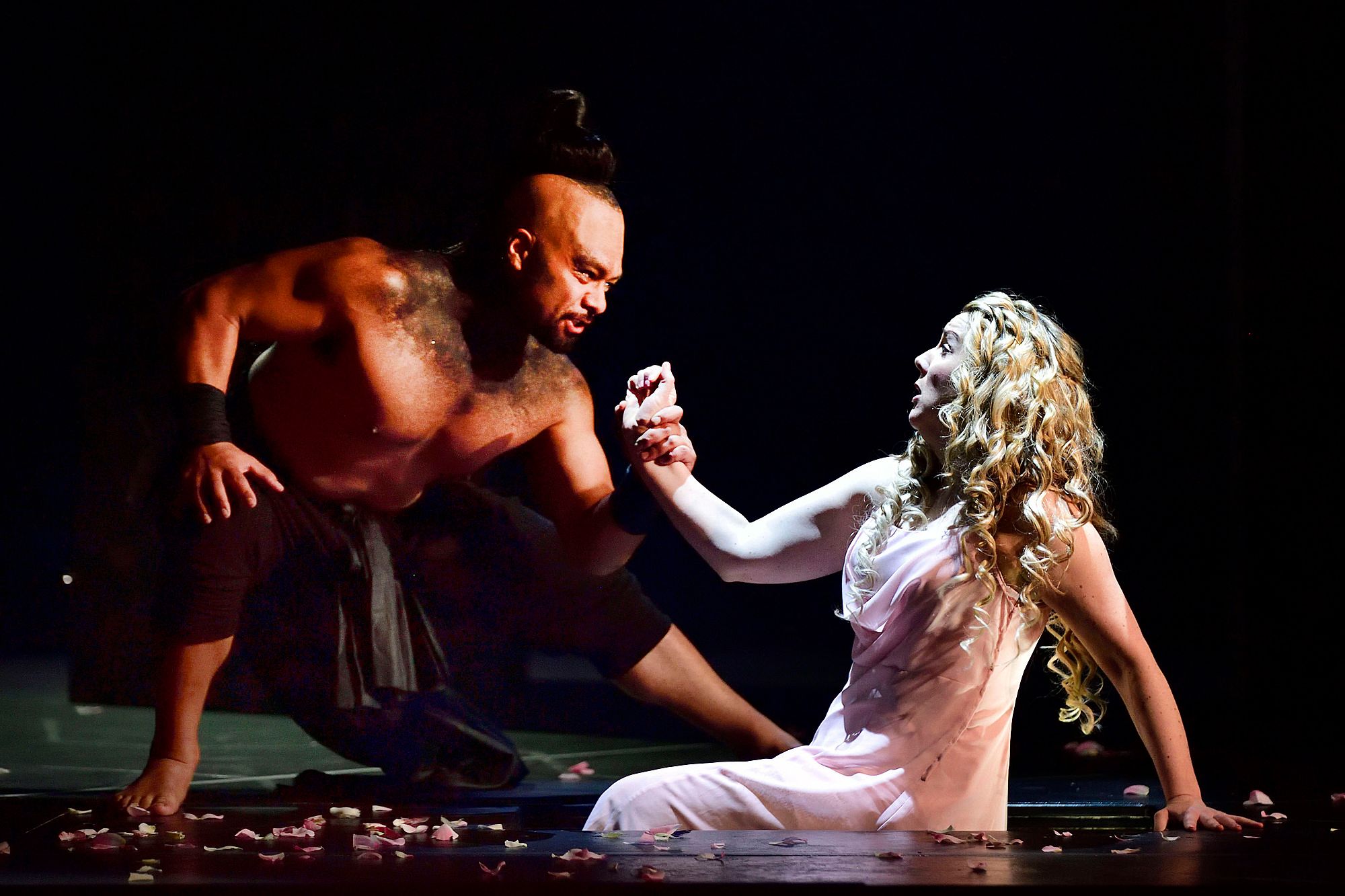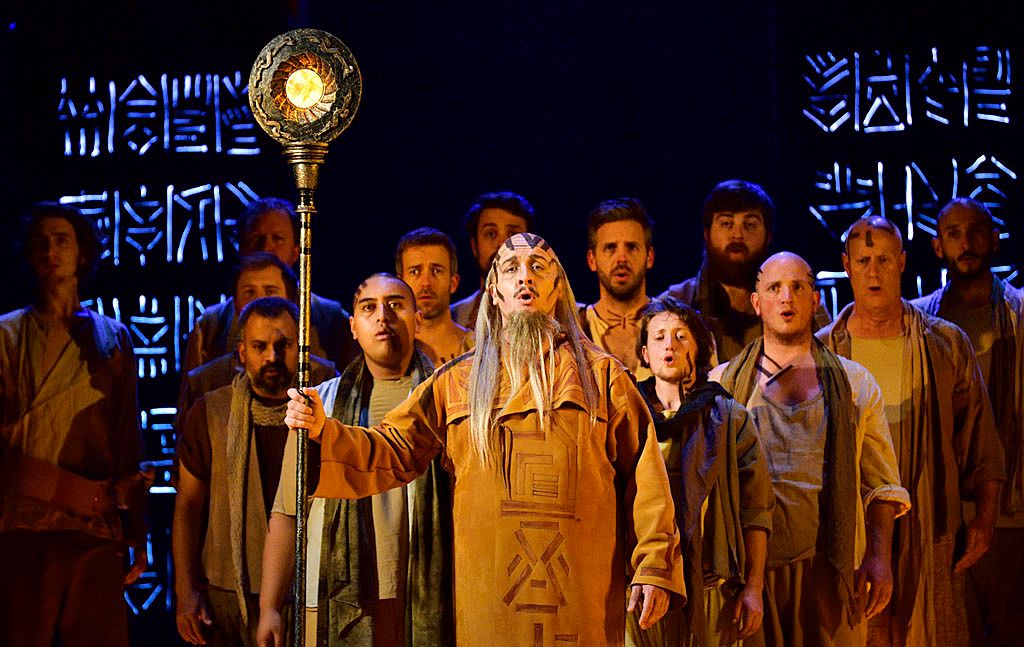Review: The Magic Flute
New Zealand Opera's production of 'The Magic Flute' whitewashes most of the show's problematic aspects, giving us a production that's awkwardly blind to 21st-century concerns, writes Alex Taylor.
New Zealand Opera’s production of The Magic Flute whitewashes most of the show’s problematic aspects, giving us a production that’s awkwardly blind to 21st-century concerns, writes Alex Taylor.
Mozart’s The Magic Flute is a strange beast. The plot runs something like this: Sarastro, the head of a religious brotherhood, gets his black servant Monostatos to kidnap the Queen’s daughter Pamina so he can marry her off in a cult initiation ceremony. The Queen, denouncing the patriarchy, tries to rescue her daughter via a young prince, Tamino, who instead gets initiated into the cult as well. As punishment, the Queen and her followers are cast into endless night (hell). We are supposed to celebrate.
In the programme booklet, director Sara Brodie describes “universal” themes and a “hidden mystery to be revealed”. But the substance of those universal themes is that women are irrational, vengeful and dangerous and that men are wise, orderly guardians of the philosophical and spiritual realm. The union of man and woman in marriage rites is the only way to save the world from chaotic femininity.
With its crude thematic strands, The Magic Flute is inescapably dualistic, but that dualism doesn’t have to be presented in an unquestioning or simplistic way, as it is here in New Zealand Opera’s lavish production. There’s ample room for interpretation and adaptation. This is a work of sometimes vague symbolism, a patchwork of various musical and theatrical influences. It might be unfair to simply call it an opera with its spoken dialogue, its pandemoniacal plot, its borrowings from Baroque and folk musics and its Egyptian and Masonic references... and when you see and hear the joy of Papageno’s epicureanism, there’s even a hint that Mozart was a closet satirist underneath all that po-faced ceremony and well-proportioned orderliness.
So there’s a lot to explore, and perhaps even to critique or satirise, but this production’s reverence for superficial aspects of beauty blinds itself to the opera’s own shortcomings in substance and interpretation. This was a missed opportunity to bring The Magic Flute kicking and screaming into the harsh light of the 21st century.
The overall approach is one of tinkering around the edges: little sexed-up bits of dialogue and action, some welcome relief in bawdy physical comedy, gigantic props, and a bland and more than occasionally awkward English translation of the German libretto: the English and the clumsy rhyming couplets throughout make the misogyny all the more cringeworthy. Instead of importing a staid and literal translation, why not commission a new translation specifically for the production? With all the spoken dialogue, the language has an unusually strong impact and a smart (and even subversive) translation could have enhanced and guided the interpretation.
I suspect the softly-softly approach (and the choice to stage the work in English) is guided by a desire to include, to reach out to a wider audience. But despite the tinkering, it’s a thoroughly old-fashioned, unhip, mind-numbingly literal production that I would argue alienates more of its audience than it beguiles with magic. To whitewash The Magic Flute with the idea that it’s a fairytale is bogus. It deals with gender relations, power, prejudice, racism – are we really supposed to ignore all of that?
To whitewash The Magic Flute with the idea that it’s a fairytale is bogus. It deals with gender relations, power, prejudice, racism – are we really supposed to ignore all of that?
If we’re taking Mozart by his word, as this production mostly does, then the Queen of the Night’s desire to reclaim her daughter at any price has to be hyper-real and dangerous; so dangerous that Sarastro’s supposedly beneficent cult must violently cast her and her ilk into hell. The feminine, characterised here (however simplistically) by night, emotion, sexuality and revenge, needs to be seen as a threat to the strict enlightenment values that Sarastro claims to uphold.
Wade Kernot, who shone in his baritone role for Brass Poppies, is woefully miscast as Sarastro, whose most authoritative (authoritarian?) bass tones were well beyond Kernot’s reach. All the power in this opera is vested in Sarastro, and if he’s less than convincing, then the quasi-Masons’ idolatry of him seems a tad pathetic.
At the other end of the vocal spectrum, Ruth Jenkins-Róbertsson not only had to contend with the directorial caricature of the Queen of the Night (old, physically disabled and inexplicably hysterical), but the extreme coloratura demands of the role. While her runs were impressive, what makes this role special are the superhuman vocal somersaults in the high register. The queen’s starflaming grief and anger was recalled in Mozart’s deathbed hallucinations, such was her impact on the composer. Jenkins-Róbertsson had moments of poignancy and imperiousness but the famous arpeggiated acrobatics that define the role (and, for many, define opera – fantastical and compelling) were marred by squeaks and ragged breathing.
Having said that, the cast of principals are more than competent. For me, the standout was Samuel Dundas’s Papageno, who carried his role with swagger and self-deprecation, and came to life opposite Madison Nonoa’s effervescent Papagena. As Pamina, Emma Fraser gave us real emotion, and her big aria, despite the naff English translation, was a vocal highlight of the show. James Clayton was commanding as Sarastro’s right-hand man, so much so that he upstaged Wade Kernot in their shared scenes. Amelia Berry made the most of her sparkling cameo as First Lady. The orchestra, too, was clean, precise, and lyrical when required, with some luxurious colours from the bassoons and oboes in particular. As usual the troops were expertly marshalled by conductor Wyn Davies, who kept the phrasing taut and well-balanced.
The staging gave us some memorable images: Pamina’s rather lurid body shots on giant rectangular screens (as if we needed reminding that in the world of Flute, women have only one purpose); a white-clad Tamino, lit like a dove at a Michael Jackson concert; and a huge, threateningly realistic hairy black spider. But the most striking images were the unforgivable faux pas: a half-naked black man strung up by a lynch mob; that very mob enacting the nearest thing you’ll see to a Hitler salute outside of a Trump rally; and perhaps the most chilling, the cloth bags over the heads of Tamino and Papageno as they are led away to be tried. How can we pretend as an audience that we don’t live in the age of ISIS and Abu Ghraib? If these images were intentional, we needed a very different reading of Sarastro and the ‘happy’ ending he engineers.
How can we pretend as an audience that we don’t live in the age of ISIS and Abu Ghraib?
Many of The Magic Flute’s ideological problems are difficult, fundamental ones. But that doesn’t excuse them from being addressed. Monostatos is a self-hating black man in the service of a benevolent white dictator (Sarastro). In kidnapping Pamina, Monostatos attempts to rape her and is subsequently punished violently and publicly by his masters. But the way Monostatos is caricatured in this production is inexcusable: he’s given all the trimmings of the stereotypical ‘savage barbarian’: he’s shirtless, with a high ponytail, dark makeup, raspy, uninflected speech, and an aggressive, deliberately ugly vocal style; he’s like an unsympathetic version of Khal Drogo, the Dothraki warlord from Game of Thrones. The ‘it’s opera, you’re reading too much into it’ argument doesn’t wash here, and it’s criminal to present these stereotypes not only unquestioned, but to not-so-tacitly endorse the overt racism of the original.
The same week Auckland Theatre Company has given us That Bloody Woman – a musical about New Zealand’s greatest feminist icon, Kate Sheppard – NZ Opera has given us a cringe-fest of unquestioned 18th-century values under the guise of ‘accessibility’. Just as Sarastro’s version of humanity is only accessible to those who give up passion and individuality (the Queen, a proud woman, and Monostatos, a black man, can never hope to conform), NZ Opera’s production is only really accessible to anyone willing to indulge in a bit of low-key casual bigotry.
Opera as a form is inherently a revolutionary one, especially as Mozart imagined it, embodying and politicising the enlightenment ideals of his time. But in order for opera to deliver on that revolutionary promise in the 21st century, it needs opinions and agendas. Opera needs a feminist agenda. A black agenda. A gay agenda. There’s no risk in this Magic Flute and no challenge to an audience, who happily deem the production a success based on a pretty visual and sonic aesthetic. No one is offering an opinion here and no one is prepared to fail. The reason grand opera seems to be struggling in this part of the world? Anyone with an opinion has left the room.
The Magic Flute
plays at the Aotea Centre
16 – 26 June 2016



